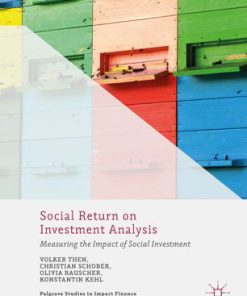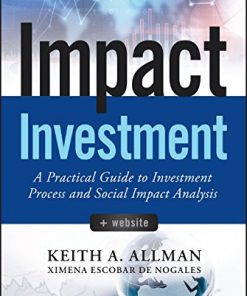The uses of social investment 1st Edition by Anton Hemerijck 019879049X 9780198790495
$50.00 Original price was: $50.00.$25.00Current price is: $25.00.
The uses of social investment 1st Edition by Anton Hemerijck – Ebook PDF Instant Download/Delivery:019879049X,9780198790495
Full download The uses of social investment 1st Edition after payment
Product details:
ISBN 10:019879049X
ISBN 13:9780198790495
Author: Anton Hemerijck
The Uses of Social Investment provides the first study of the welfare state, under the new post-crisis austerity context and associated crisis management politics, to take stock of the limits and potential of social investment. It surveys the emergence, diffusion, limits, merits, and politics of social investment as the welfare policy paradigm for the 21st century, seen through the lens of the life-course contingencies of the competitive knowledge economy and modern family-hood.
Featuring contributions from leading scholars in the field, the volume revisits the intellectual roots and normative foundations of social investment, surveys the criticisms that have leveled against the social investment perspective in theory and policy practice, and presents empirical evidence of social investment progress together with novel research methodologies for assessing socioeconomic ‘rates of return’ on social investment. Given the progressive, admittedly uneven, diffusion of the social investment policy priorities across the globe, the volume seeks to address the pressing political question as to whether the social investment turn is able to withstand the fiscal austerity backlash that has re-emerged in the aftermath of the global financial crisis.
The uses of social investment 1st Table of contents:
Part 1. Introduction
1. Social Investment and Its Critics
1.1 The Social Investment Turn
1.2 Why We Need a New Welfare State Revisited
1.3 Social Investment Critics
1.4 Towards an Institutional Perspective: Stocks, Flows, and Buffers
1.5 Institutional Complementarities and Life-Course Synergy Effects
1.6 Politics of Social Investment Reform in Times of Post-Crisis Austerity
1.7 Outline of the Volume
Part 2. Limits to Social Investment
2. Social Investment: The Thin Line between Evidence-Based Research and Political Advocacy
2.1 Introduction
2.2 Is Social Investment a Robust Concept and Analytical Framework?
2.3 Social Investment, Growth, and Employment
2.4 Social Investment as a Platform
2.5 Conclusions
3. ‘Social Investment’: With or Against Social Protection?
3.1 Introduction
3.2 Conceptual Issues: Political and Scientific Notions of Social Investment
3.3 Social Protection and Social Investment
3.4 Social Investment in the Future?
4. Family Relationships and Gender Equality in the Social Investment Discourse: An Overly Reductive View?
4.1 The Shifting Symbolic Balance in the Work–Family Conciliation Construct
4.2 An Unfinished Revolution Pour Cause?
4.3 Concluding Remarks
5. Social Investment and the Matthew Effect: Limits to a Strategy
5.1 Introduction
5.2 Human Capital Investment: Early Childhood Education and Care
5.3 Human Capital Investment: Higher Education
5.4 Active Labour-Market Policies
5.5 Discussion: How to Ensure the Future Success of Social Investment?
6. The ‘New Welfare State’ under Fiscal Strain: Austerity Gridlocks and the Privatization of Risk
6.1 Introduction
6.2 Social Investment in the Age of Permanent and Acute Austerity
6.3 From Austerity Gridlocks to Risk Privatization?
6.4 Conclusion
Part 3. Social Investment Endowment and Extensions
7. Enabling Social Policy
7.1 Promoting Employment
7.2 Does Social Investment Work?
7.3 What Policies and Policy Configurations are Most Effective?
7.4 Will Social Investment Be a Complement to Social Protection or a Substitute?
8. Social Investment and the Service Economy Trilemma
8.1 Introduction
8.2 The ICT Revolution and High Productivity Services Sectors: Implications for the Trilemma
8.3 Social Investment and Dynamic Service Expansion
8.4 Conclusion
9. Towards Employment Insurance?
9.1 Introduction
9.2 Increasing Labour-Market Risks through Labour-Market Flexibilization
9.3 Why Should these New Social Risks Be Covered by Social Insurance?
9.4 Which New Risks should Be Included in an Extended (Un)Employment Insurance?
9.5 Conclusion
10. Social Investment and Childcare Expansion: A Perfect Match?
10.1 Introduction
10.2 Investing in Early Years and Its Critics
10.3 Diversity in ECEC Developments
10.4 Conclusion
11. Addressing Human Capital Risks and the Role of Institutional Complementarities
11.1 Introduction
11.2 Investing in Human Capital over the Life Course
11.3 Designing a Social Investment Approach and Institutional Complementarities
11.4 Gauging Institutional Complementarities
11.5 Discussion and Conclusion
12. Capacitating Services and the Bottom-Up Approach to Social Investment
12.1 Introduction
12.2 The Intertemporal Problem in Social Investment
12.3 The Limits of Ex Ante Calculation and Coalition Building for Comprehensive Reform
12.4 The Bottom-Up Approach in Action: A German Example
12.5 A Dutch Prospect
12.6 Conclusion
13. A Normative Foundation for the Social Investment Approach?
13.1 Beyond Economic Growth: Social Investment and Social Progress
13.2 Equality of What? A Multidimensional and Agency-Oriented Approach
13.3 Measuring Social Returns on Social Investments
13.4 Conclusion
Part 4. Social Investment Assessment: Conceptualization and Methods
14. Practical Pluralism in the Empirical Study of Social Investment: Examples from Active Labour-Market Policy
14.1 The Perennial Challenges and Choices
14.2 Multifaceted Character of Social Investment
14.3 Multiplicity of ‘Returns’
14.4 Social Investment Policy Complementarities and Clashes
14.5 Conclusion: Coping through Practical and Pluralist Empiricism
15. Social Investment and Its Discount Rate
15.1 What is Meant By Investment?
15.2 What is an Appropriate Discount Rate?
15.3 Coping with Uncertainty around Outcomes
15.4 The Assets from Social Investment and their Distribution
15.5 Social Impact Investment
15.6 Policy Considerations
16. Conceptualizing and Measuring Social Investment
16.1 Conceptualizing Social Investment
16.2 Measuring Social Investment
17. Measuring Social Investment Returns: Do Publicly Provided Services Enhance Social Inclusion?
17.1 Introduction
17.2 Distributive Impact of the In-Kind Benefit of Capacitating Social Services
17.3 Employment and Long-Term Inequality Effects of Publicly Provided Services
17.4 Conclusion
Part 5. Comparative Social Investment Experience
18. Developing and Spreading a Social Investment Perspective: The World Bank and OECD Compared
18.1 The World Bank: A Social Investment Perspective after the Washington Consensus
18.2 The OECD: Quick Off the Mark but Poorly Coordinated
18.3 The Current State of Play
19. De-universalization and Selective Social Investment in Scandinavia?
19.1 Introduction
19.2 Universalism and Social Investment
19.3 The Political Robustness of the Universal Welfare State
19.4 A Trend towards De-universalization?
19.5 Conclusion
20. The Truncated German Social Investment Turn
20.1 Introduction
20.2 Methodological Considerations
20.3 Explaining Policy Change
20.4 Conclusion
21. The Impact of Social Investment Reforms on Income and Activation in the Netherlands
21.1 Introduction
21.2 The Dutch Social Investment Turn and Its Reversal?
21.3 Assessing Social Investment Buffers
21.4 Assessing Social Investment Flow Arrangements
21.5 Conclusion
22. Ireland: The Evolving Tensions between Austerity, Welfare Expansion, and Targeted Social Investment
22.1 Introduction
22.2 Ireland’s Welfare Regime in the Celtic Tiger Years
22.3 Social Investment as an Overlapping Consensus: The Developmental Welfare State
22.4 Policy Directions during the Crisis and After
22.5 Assessing the Story of Social Investment in Ireland
23. Social Investment in a Federal Welfare State: The Quebec Experience
23.1 A Provincial Welfare State
23.2 The Social Investment Turn
23.3 The New Quebec Model
23.4 Conclusion
24. A Social Investment Turn in East Asia? South Korea in Comparative Perspective
24.1 The East Asian Developmental Welfare State
24.2 Public Social Investment Policies and the Rise of Family Policy
24.3 The Rise of Private Social Investments in Korea
24.4 Conclusions
25. Social Investment in Latin America
25.1 Introduction
25.2 Social Investment in the Latin American Context
25.3 Advances and Persistent Barriers: The Case of Conditional Cash Transfers
25.4 Advancing Social Investments in Latin America
26. Why No Social Investment in Italy: Timing, Austerity, and Macro-Level Matthew Effects
26.1 Introduction
26.2 Social Investment in Italy: An Introduction to the Context
26.3 Social Investment Policies in Italy
26.4 Social Investment in Italy: A Mission Impossible?
Part 6. EU Social Investment Advocacy
27. Social Investment for a Cohesive and Competitive European Union
27.1 Introduction
27.2 The Development of Social Policies in the European Union
27.3 EU Policy Guidance towards Social Investment
27.4 Supporting Member States Implement Social Investment
27.5 Moving Forward
28. Can European Socioeconomic Governance Be Social Investment Proof?
28.1 New Socioeconomic Governance and the Options for Social Investment
28.2 Country-Specific Recommendations Stemming from SGP Coordination
28.3 CSRs in their Context: More Views on a Potential Investment Approach
29. Social Investment as a Policy Platform: A European Argument
29.1 Social Investment as a Policy Platform for the EU
29.2 A Policy Platform or a Scientific Paradigm?
29.3 Instead of Upward Convergence, Poor Social Investment Will Generate Further Divergence in the EU
29.4 Conclusion: A Matter of Common Concern, to Be Embedded in EU Economic and Budgetary Governance
30. Accelerator or Brake? The EU and the Difficult Politics of Social Investment
30.1 Introduction
30.2 Discursive Persuasion
30.3 Institutional Pressure and ‘Capacitation’
30.4 Making the Case for Social Investment: Framing Mistakes
30.5 Strengthening Capacity: The Unexploited Potential
30.6 Conclusion
Part 7. The Politics of Social Investment
31. The Politics of Social Investment: Policy Legacies and Class Coalitions
31.1 Introduction
31.2 Contextualizing Social Investment Politics
31.3 Empirical Illustration: Family Policy Development in Bismarckian Welfare States: France, Germany, and Switzerland
31.4 Conclusion
32. Three Challenges for the Social Investment Strategy: Investing in the Future, Taxes, and the Millennials
32.1 Introduction
32.2 The Problem of Time Horizons: Social Investment Requires Patient Capital
32.3 Where Will the Money Come From? The Revolution in Tax Theory and Slow Economic Growth
32.4 Generational ‘Luck’ and the Millennials
32.5 Conclusion
33. Public Opinion and the Politics of Social Investment
33.1 Introduction
33.2 Theoretical Expectations
33.3 Measuring Public Opinion on Social Investment
33.4 Empirical Evidence
33.5 Conclusions
34. Social Investment, Social Democracy, Neoliberalism, and Xenophobia
34.1 Revising and Reclaiming the SIWS Strategy
34.2 Conclusion
Part 8. Conclusion
35. The Uses of Affordable Social Investment
35.1 Social Investment at a Crossroads
35.2 From an Aspirational Metaphor to a Coherent Policy Paradigm
35.3 From Paradigm Change to Methodological Triangulation
35.4 From Transformative to Virtuous Institutional Policy Complementarities
35.5 Towards a More Assertive Politics of Social Investment in Hard Times
35.6 Squaring Social Investment Progress and Fiscal Prudence for Europe
People also search for The uses of social investment 1st:
the use of savings to earn a financial return
the prosperity of the stock market in the 1920s
what is one of the benefits of a sociological perspective
the uses of social investment
b. the use of money
Tags:
Anton Hemerijck,investment,uses,social
You may also like…
Politics & Philosophy
Aristotle on the Uses of Contemplation 1st Edition Matthew D. Walker
Biology and other natural sciences - Ecology
Soil Nitrogen Uses and Environmental Impacts First Edition Lal
Politics & Philosophy
Business & Economics
Commercial & Financial Law
Treaty shopping in international investment law First Edition Baumgartner 0191090824 9780191090820
Business & Economics
Chains of Finance: How Investment Management is Shaped First Edition Diane-Laure Arjalies
Politics & Philosophy - Warfare & Defence
Business & Economics - Investing













